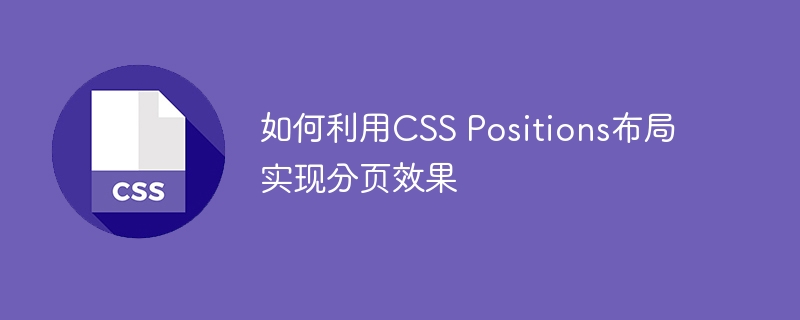How to use CSS Positions layout to achieve paging effect

How to use CSS Positions layout to achieve paging effect
In web design, paging effect is a common layout method used to divide content into multiple pages , and provide navigation functions. CSS Positions is a layout method of CSS that can help us achieve paging effects. This article will introduce in detail how to use CSS Positions layout to achieve paging effect, and give specific code examples.
1. Basic layout
First, we need to create a basic HTML structure, including content containers and navigation controls. The code is as follows:
<div class="content"> <div class="page">第一页内容</div> <div class="page">第二页内容</div> <div class="page">第三页内容</div> </div> <div class="pagination"> <button class="prev">上一页</button> <button class="next">下一页</button> </div>
In the above code, the content container is wrapped with <div class="content">, and the content of each page is wrapped with < ;div class="page"> to represent. The navigation control is wrapped using <div class="pagination">, and the previous page and next page are wrapped using <button class="prev"> and ## respectively. #
.content {
position: relative;
width: 300px;
height: 200px;
overflow: hidden;
}
.page {
position: absolute;
top: 0;
left: 0;
width: 100%;
height: 100%;
transition: transform 0.5s ease-in-out;
}
.pagination {
text-align: center;
margin-top: 10px;
}
.prev, .next {
margin: 0 10px;
}position: relative; for the content container and limit the width and height, while passing overflow: hidden ;Hide the portion that exceeds the container size.
position: absolute;, and placed in the upper left corner of the container through top: 0; left: 0;. At the same time, in order to achieve the page switching effect, we use the transition attribute of CSS animation.
- JavaScript interaction
var content = document.querySelector('.content');
var pages = document.querySelectorAll('.page');
var prevBtn = document.querySelector('.prev');
var nextBtn = document.querySelector('.next');
var currentPage = 0;
prevBtn.addEventListener('click', function() {
if (currentPage > 0) {
currentPage--;
content.style.transform = 'translateX(' + (currentPage * -100) + '%)';
}
});
nextBtn.addEventListener('click', function() {
if (currentPage < pages.length - 1) {
currentPage++;
content.style.transform = 'translateX(' + (currentPage * -100) + '%)';
}
});currentPage to represent The current page number.
addEventListener method to bind click events to the previous page and next page buttons, and update the value of currentPage in the event handler function, And achieve the page switching effect by setting content.style.transform.
The above is the detailed content of How to use CSS Positions layout to achieve paging effect. For more information, please follow other related articles on the PHP Chinese website!

Hot AI Tools

Undresser.AI Undress
AI-powered app for creating realistic nude photos

AI Clothes Remover
Online AI tool for removing clothes from photos.

Undress AI Tool
Undress images for free

Clothoff.io
AI clothes remover

AI Hentai Generator
Generate AI Hentai for free.

Hot Article

Hot Tools

Notepad++7.3.1
Easy-to-use and free code editor

SublimeText3 Chinese version
Chinese version, very easy to use

Zend Studio 13.0.1
Powerful PHP integrated development environment

Dreamweaver CS6
Visual web development tools

SublimeText3 Mac version
God-level code editing software (SublimeText3)

Hot Topics
 Adding Box Shadows to WordPress Blocks and Elements
Mar 09, 2025 pm 12:53 PM
Adding Box Shadows to WordPress Blocks and Elements
Mar 09, 2025 pm 12:53 PM
The CSS box-shadow and outline properties gained theme.json support in WordPress 6.1. Let's look at a few examples of how it works in real themes, and what options we have to apply these styles to WordPress blocks and elements.
 Demystifying Screen Readers: Accessible Forms & Best Practices
Mar 08, 2025 am 09:45 AM
Demystifying Screen Readers: Accessible Forms & Best Practices
Mar 08, 2025 am 09:45 AM
This is the 3rd post in a small series we did on form accessibility. If you missed the second post, check out "Managing User Focus with :focus-visible". In
 Create a JavaScript Contact Form With the Smart Forms Framework
Mar 07, 2025 am 11:33 AM
Create a JavaScript Contact Form With the Smart Forms Framework
Mar 07, 2025 am 11:33 AM
This tutorial demonstrates creating professional-looking JavaScript forms using the Smart Forms framework (note: no longer available). While the framework itself is unavailable, the principles and techniques remain relevant for other form builders.
 Create an Inline Text Editor With the contentEditable Attribute
Mar 02, 2025 am 09:03 AM
Create an Inline Text Editor With the contentEditable Attribute
Mar 02, 2025 am 09:03 AM
Building an inline text editor isn't trivial. The process starts by making the target element editable, handling potential SyntaxError exceptions along the way. Creating Your Editor To build this editor, you'll need to dynamically modify the content
 Making Your First Custom Svelte Transition
Mar 15, 2025 am 11:08 AM
Making Your First Custom Svelte Transition
Mar 15, 2025 am 11:08 AM
The Svelte transition API provides a way to animate components when they enter or leave the document, including custom Svelte transitions.
 Working With GraphQL Caching
Mar 19, 2025 am 09:36 AM
Working With GraphQL Caching
Mar 19, 2025 am 09:36 AM
If you’ve recently started working with GraphQL, or reviewed its pros and cons, you’ve no doubt heard things like “GraphQL doesn’t support caching” or
 File Upload With Multer in Node.js and Express
Mar 02, 2025 am 09:15 AM
File Upload With Multer in Node.js and Express
Mar 02, 2025 am 09:15 AM
This tutorial guides you through building a file upload system using Node.js, Express, and Multer. We'll cover single and multiple file uploads, and even demonstrate storing images in a MongoDB database for later retrieval. First, set up your projec
 Comparing the 5 Best PHP Form Builders (And 3 Free Scripts)
Mar 04, 2025 am 10:22 AM
Comparing the 5 Best PHP Form Builders (And 3 Free Scripts)
Mar 04, 2025 am 10:22 AM
This article explores the top PHP form builder scripts available on Envato Market, comparing their features, flexibility, and design. Before diving into specific options, let's understand what a PHP form builder is and why you'd use one. A PHP form






